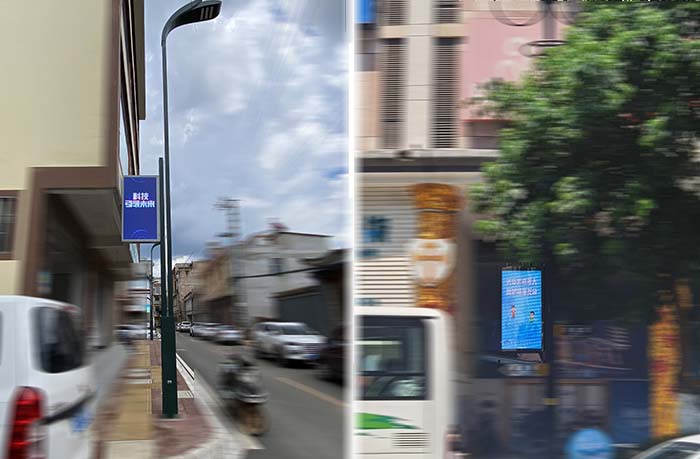led pole digital signage are becoming increasingly popular in metropolitan contexts. They are suitable for advertising, information display, and aesthetics. When selecting an appropriate screen, everyone should have considered screen thickness. Should we select a thicker or thinner one? In truth, there is no absolutely typical response. The greatest option is one that is appropriate for the individual setting. However, if you can learn the following reference points, they will assist you understand the thickness issue.
Digital signage is a broad notion. LED pole digital signage, often known as pole LED screen, is one of several types of digital signage. If you are looking for LED items or don’t know how to choose the best LED product for you, read this article: Digital Signage | what is it? | where is it used?
I feel it will undoubtedly benefit you.

Understanding led pole digital signage
Before that, let’s take a quick glance at the LED light pole screen:
LED light pole screens are digital displays mounted on light poles, combining illumination and advertising or information display. They utilize light-emitting diodes (LEDs) to produce bright, vivid images.
In addition to the thickness issue, which we will examine today, there are a few more aspects to consider:
Pixel Pitch (P Value):
Refers to the distance between pixels. A smaller P value indicates higher resolution, essential for clear visuals.
Brightness:
Measured in nits (cd/m²), brightness levels of at least 5000 nits are recommended for outdoor visibility.
Protection Rating:
An IP65 rating ensures the screen is dust-tight and protected against water jets, making it suitable for outdoor use.
Energy-Saving Performance:
Choose an light pole LED screen with energy-saving features such as sophisticated power management and timed operation via remote control. This helps to lower long-term running expenses by eliminating energy waste.
Heat Resistance and Dissipation:
Outdoor screens must withstand high temperatures. Choose screens with effective heat dissipation systems and casings made of materials such as aluminum or magnesium-aluminum alloy. This improves heat management and increases the equipment’s lifespan.
Remote Control and Monitoring:
Choose screens that permit remote control. This enables simple content updates, brightness adjustments, and device status checks, making it perfect for large-scale urban administration.
Installation and Maintenance:
Look for designs that are simple to install and maintain. A modular design enables individual component repairs without disassembling the complete screen, decreasing installation time and costs.

What characteristics will be influenced by the variation in thickness?
1. Visual Performance
Thinner LED light pole screens often provide more uniform light distribution. This feature enhances color vibrancy, especially in high-brightness environments. Users can expect:
Better Color Representation: Thinner designs typically have less obstruction to light, resulting in more vivid and true-to-life colors.
Enhanced Viewing Angles: Thin screens can offer broader viewing angles, making them more effective in public spaces where viewers are dispersed.
2. Heat Dissipation
Heat management is critical for the longevity and performance of LED screens. Thicker screens usually incorporate better heat dissipation systems:
Effective Heat Management: Thicker designs can house advanced cooling systems, extending the lifespan of the LEDs and maintaining consistent performance.
Risks of Overheating: Too thin designs may struggle with heat dissipation, leading to performance degradation and reduced lifespan.

3. Ease of Installation
Thinner led pole digital sign are generally easier to install. Their lightweight design simplifies the installation process, which can be crucial for projects with time constraints.
Reduced Installation Time: A lighter screen can be installed faster, minimizing labor costs and downtime.
4. Maintenance Efficiency
Maintenance is a key factor in the total cost of ownership. Thinner screens usually occupy less space and are easier to access:
Simplified Access: A lighter design makes it easier to perform routine maintenance and repairs, reducing the need for complex equipment.
Lower Maintenance Costs: Quicker maintenance procedures can lead to reduced costs over the lifespan of the product.
5. Cost Considerations
When evaluating thickness, cost is an essential factor. Thinner screens often have higher material and production costs due to the advanced technologies required:
Material Quality: Thinner screens may use higher-quality materials, contributing to a higher price point.
Budget Constraints: Users must balance their budget against the desired quality and features, considering the long-term benefits of investing in thinner technology.

6. Weather Resistance
Outdoor light pole LED digital signage must withstand various weather conditions. Thicker screens are usually more robust and better equipped to handle extreme weather:
Structural Integrity: Thicker designs can resist wind and rain better, ensuring long-term reliability in harsh conditions.
Advancements in Technology: Many modern thin screens also feature durable materials and designs, making them suitable for outdoor use. It’s crucial to evaluate the specific materials and construction quality.
7. Long-Term Reliability
Choosing the right thickness impacts the screen’s overall durability and maintenance cycle:
Longevity: Thicker screens generally have a longer operational life due to better heat management and structural integrity.
Warranty Considerations: Check warranty terms, as thicker screens may come with longer warranties due to their enhanced durability.

Conclusion: Making an Informed Choice
Choosing the thickness of an led pole digital signage is not a case of “thicker is better” versus “thinner is better”. Given the variables discussed in this article, the conclusion is that a smaller design may be best suited for projects that emphasize visual effects and current aesthetics. In contrast, for applications that prioritize durability and heat dissipation, a relatively thicker screen is necessary.
When selecting an outdoor LED light pole screen, conduct a thorough review based on the unique application situation, visual requirements, and environmental circumstances, and speak with the manufacturer to ensure that you pick the best decision for your needs.
If you have such needs, please feel free to contact us!
(All the pictures in the article are our actual cases)
 Tecnon Smart Display Technology Shenzhen Co., Ltd.
Tecnon Smart Display Technology Shenzhen Co., Ltd.